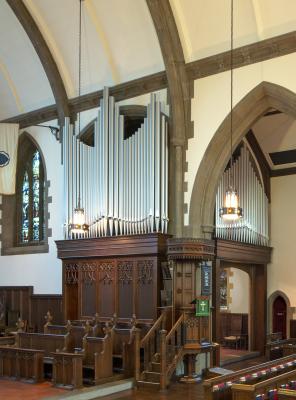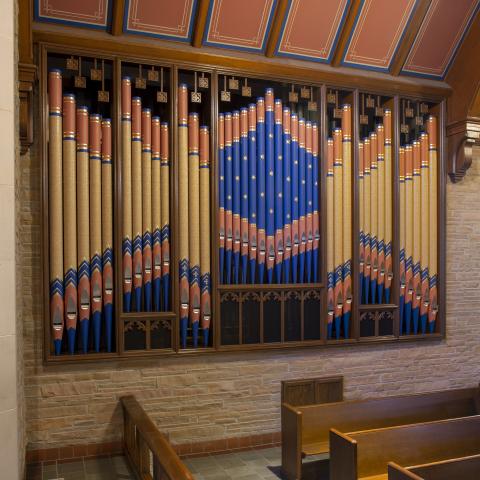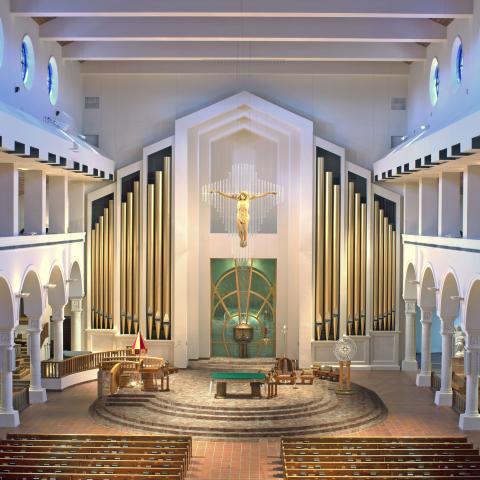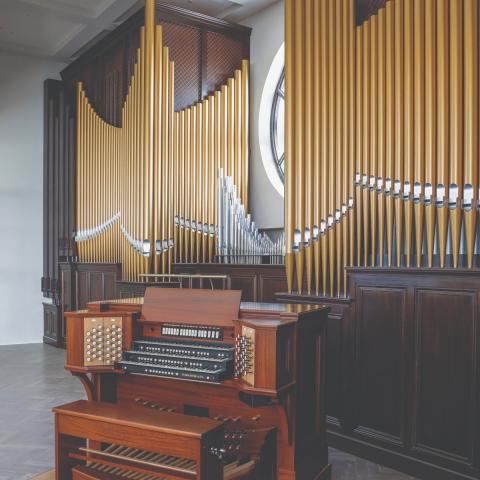Schoenstein & Co., Benicia, California; The Church of the Redeemer, Chestnut Hill, Massachusetts

Two perspectives
Sterling Anglican music program, perfect acoustics, an engaged parish—heaven-on-earth for an organbuilder, but only if the right people are on board to help. Many of our projects have been aided by excellent professional consultants, but this one might not have happened at all without the steady hand of Sean O’Donnell. He was mentor, organizer, and problem solver. In addition to all the usual issues such as navigating the changing of the fabric of a beloved architectural gem to accommodate the organ, his diplomatic skill was an immense help to the rector in convincing the parish of the need for change even though the existing instrument was relatively new. We were very pleased when the parish extended Sean’s engagement to supervise all of the architectural, electrical, and mechanical preparations for our installation. A highly experienced and skilled organ technician, he knew exactly what we needed. He also followed the time-honored practice of the best organ consultants—leaving the musical decisions entirely to musician and builder.
—JMB
The consultant’s role
Next to the church building itself, a pipe organ is usually the most valuable and longest-lived asset a church will have. Acquiring or restoring one is a daunting task that has not likely been undertaken in recent memory, or even within living memory. There are a great many goals to discern, details to attend, and challenges to meet—to help with this process, the community will often hire a consultant. The consultant’s role is not to do this work for the community, but to provide the education, information, and tools the community needs to create an instrument that will serve their needs far into the future. The overall process is iterative: defining project goals will be followed by exploring instruments that meet those goals, but that exploration will inform, refine, and even change those goals.
As the project comes into tighter focus, the consultant recruits qualified firms to submit proposals, ensuring that the firms understand the unique needs and goals of the church. As the proposals are evaluated, the consultant guides the committee by providing resources to clarify concepts that may be unfamiliar, and by making sure that all aspects of the project have been clearly addressed. There are many musical options available, and many talented organbuilders. With the right information and a little guidance, a community can easily acquire a fine pipe organ well suited to their current and future needs, and even enjoy the process.
It was a great joy to work with Church of the Redeemer. They embraced the challenges and myriad details with enthusiasm and dedication as they worked through whether to restore or rebuild their existing instrument, acquire a vintage instrument, or, as they ultimately decided, commission a new instrument.
There was much to learn, and the first part of the process was a series of listening exercises, starting in their own church so that folks who sit in the same seats every Sunday (like so many of us) could listen from the organist’s perspective, from the choir’s perspective, and from various places in the nave. We even had a set of test pipes that we were able to install in two different instruments to hear how much the room affected their sound. From there we branched out, listening to organs in a variety of styles by current and historic builders. After each listening session, the organist and the committee spent a few minutes listing words or short phrases describing the instrument: words like clarity, mystery, clean, flexible, warm, etc. As they developed a vocabulary, we began to discuss which of those attributes they wanted in their pipe organ, and focused on those options. Through all of this the organs were demonstrated by the same organist, using the same set of pieces drawn from Redeemer’s repertoire.
Choosing from among the organbuilders who so eagerly shared their knowledge and creativity was the next challenge, and the committee ultimately commissioned the instrument from Schoenstein & Co. From start to finish it was important to ensure that potential builders understood both the possibilities and the limitations of the project, and that the organ committee had mastered the architectural and structural issues, scheduling and budgets, subcontracts and side jobs, and the many, many other details comprising a project of this magnitude.
With the solid support of the rector, Fr. Michael Dangelo, organist Michael Murray, and the church staff, and with the hard work and dedication of the organ committee chaired by the indefatigable Leslie Horst, The Church of the Redeemer has acquired a beautiful new pipe organ, supremely well suited to their style of worship. More importantly, it was a project they entered into with confidence and excitement and completed with pride, looking forward to generations of worship enhancing music.
—Sean O’Donnell, Consultant
A great voicer is very much in the same musical plane as a first chair member of the woodwind section in one of the Big Five symphony orchestras. A great conductor in a great concert hall is nothing without great players. Just like artistic musicianship, voicing requires skill, practice, experience, and, most of all, good musical taste. Timothy Fink, an all-round skilled organbuilder, heads our pipe shop and shares voicing duties with Mark Hotsenpiller, our head voicer.
—JMB
A voicer’s vision
The Church of the Redeemer possesses a fabulous room for church music. The nave’s acoustic properties enhance sound in a way that leaves the listener overwhelmed, overjoyed, and ultimately sonically satisfied. What a treat for an organbuilder’s commission.
The room into which any organ sounds is its resonator. A guitar has a body, a piano has a soundboard, but the organ needs a room. The qualities that make this one so lovely are: cubic volume, proportions, materials of construction, and shape of reflecting surfaces. The room is of modest size allowing an organ of modest size to fill it with sound. The proportions are classic (the architecture is based on English Gothic), meaning they are not exaggerated in one dimension. Heavy masonry construction assures that the entire frequency spectrum is reflected and the variability of the reflecting surfaces breaks up these reflections, delighting our ears.
The result of these properties is a room with an ideal reverberation period—not a long reverberation period. The musical magic happens in the milliseconds immediately after the sound is produced. The length of time the high energy lingers is Early Decay Time. This is the portion of the reflected sound to which our musical minds respond. The nave at Church of the Redeemer reflects sound at nearly the full frequency spectrum for a generous portion of the total reverberation time.
The projection of sound into the room is important, too. The organ chamber is a modestly proportioned room in an elevated position at the nave’s crossing. The short side of its rectangular shape is open to the chancel with the long side open to the nave. It too is constructed of substantial masonry materials assuring all sound frequencies are reflected out of the chamber. Here we located the Great, Swell, and some of the Pedal organs. Below the chamber and in a space between the chancel and a side chapel, we located the Choir organ. The console resides on the opposite side of this arrangement giving the organist some hearing distance from the organ. Between these two the choir’s singers are arranged in the traditional academic style. Finally, 32′ and 16′ octaves of the Pedal Open Wood are located at the back wall of the nave and the south transept. This was done out of necessity since there was no room in the chamber for these large pipes. Much care was taken to harmonize these beauties with their surroundings. Sonically, they provide a thrilling musical “push” to the organ’s ensemble.
Tonally, the organ was commissioned to function in the Anglican tradition. Mr. Murray’s love of English Victorian and Edwardian tone provided focus to this scheme. It is in our tradition to provide new organs with plenty of foundation, but the multiple diapasons in the scheme might appear to be excessive. The idea here was to use a variety of Diapason tone for musical subtlety, not power. The acoustical environment highlights the subtle difference in timbres.
To make sense of this list of Diapasons consider the following: the Great Open Diapason No. 1 is the tonal center of the organ. It possesses the largest scale and mouth width and easily supports the chorus set above. Numbers 2 and 3 progress smaller in scale and mouth width providing subtlety of musical variation. This gives the musician exacting control over the tonal center of the organ. Choruses can be thinned or fattened, stop combinations adjusted for power, or the Diapasons can simply be appreciated for their sublime solo qualities. The No. 3 is also available at 16′ and 4′, further extending the possible combinations. Sitting above these stops is a proper Principal 4′ and Mixture 2′. These reduce in scale as the pitch rises assuring that these higher pitches are suggestions of the fundamental.
The Swell Horn Diapason “No. 4” is similar in scale to the Great No. 2, but with narrow tuning slots and higher wind pressure. These attributes give it a distinct quality that bends musically to the closing of the Swell shades. It supports a Gemshorn 4′, a tapered principal. Its hybrid tone quality allows chameleon-like abilities when combined with other Swell stops. Finishing the chorus is a Mixture 2′, small in scale and carefully pitched such that it will be properly subdued with the shades closed.
The Choir Dulciana 8′ “No. 5” is the smallest of the Diapasons but with a wider mouth. Its subdued yet singing quality coupled with its expressive location next to the singers begs them to sing along. Add the 4′ Dulcet and a mini chorus is formed.
The Pedal Open Wood 32′ serves as two stops. The 8′ portion is named Grand Open Diapason 8′ “No. 6” and is comparable in scale to the Great No. 1 but on higher wind pressure. Its noble solo demeanor demands independent appearance on the Great and Choir manuals. The 32′ and 16′ portions form the Pedal Open Wood producing a stunningly solid foundation for the entire organ.
With space diminishing, the organ’s flute stops are at a minimum but still well represented. Two harmonic flutes are provided. The Great Harmonic Flute 8′ soars down the nave to listener’s delight. The Swell Flageolet 2′ has harmonic trebles imparting its sound with both blending and power qualities expected of English full Swell effects. Three stopped flutes are available: one on the Great at 8′, one on the Swell at 16′ and 8′, and one on the Choir at 8′, 4′, and 22⁄3′. They find their distinction by varying the scale and construction. The Great Bourdon 8′ is the largest scale but made of metal. The next smaller scale is in the Swell and is made of wood with pierced stoppers. The Choir Leiblich Gedeckt is smallest in scale and made of metal with narrow chimneys.
Of course, space was left for the very necessary strings and celestes. The bite and warmth of the Swell Gamba 8′ combines seamlessly its neighbor stops. Add the complementary full compass Celeste 8′ (maybe a coupler or two), and heaven is in sight. Just for contrast, the expressive Choir Unda-Maris 8′ gives an added sonic dimension to the organ’s palate. While bringing the organ to a decrescendo another color can be receded to delighting the listener with unexpected beauty.
Six ranks of reeds were somehow incorporated into this organ. Three types of trumpets, a tuba, and two color reeds provide an extensive color palate. The Great Trumpet 8′ leans toward a French quality, assuring it will stand up with all those Diapasons. The Swell Posaune and Cornopean represent a time-tested Schoenstein combination. This uses a bright, larger Cornopean at 8′ with the smaller, darker Posaune at 16′ and 8′. (The 16′ octave and a 32′ extension, all under expression, are available in the Pedal.) The musical possibilities with this arrangement are endless. The final bit to sweeten the organist’s orchestrations, both stops can be drawn together on the Choir manual as the Tuben 8′. Countering this effect is a proper Tuba 8′—unenclosed. Its 16′ extension in the Pedal employs wood resonators of powerful full and dark character.
The Oboe and Corno di Bassetto are the color reeds. The Swell Oboe Horn 8′ combines with the flue stops yet retains the piquant treble quality necessary for solo passages. The Corno di Bassetto 8′ features well in its ability to render chordal effects along with piano solo melodies.
Rounding out the tonal palate is the Schoenstein action system. Each pipe is controlled by its own valve. This allows the transmission of entire ranks to another division without the use of couplers. Each division is designed to stand for its purpose. However, by carefully selecting stops to be playable on another division or extending beyond their assigned range opens a huge door to new tonal possibilities. It unlocks the musical value already built into the organ.
—Timothy Fink, Schoenstein & Co.
—Jack M. Bethards, Schoenstein & Co.
Photo credit: Louis Patterson
GREAT (Manual II)
16′ Double Diapason 61 pipes
8′ Grand Diapason (Ch)
8′ Open Diapason No. 1 61 pipes
8′ Open Diapason No. 2 61 pipes
8′ Open Diapason No. 3 12 pipes (ext 16′)
8′ Harmonic Flute 49 pipes (Sw Horn Diapason bass)
8′ Bourdon 61 pipes
4′ Principal 61 pipes
4′ Octave (ext 16′) 12 pipes
2′ Fifteenth 61 pipes
2′ Mixture (III–IV) 187 pipes
8′ Trumpet 61 pipes
8′ Corno di Bassetto (Ch)
Cymbelstern
SWELL (Manual III, enclosed)
16′ Lieblich Bourdon (ext 8′) 12 pipes (unenclosed)
8′ Horn Diapason 61 pipes
8′ Stopped Diapason 61 pipes
8′ Echo Gamba 61 pipes
8′ Vox Celeste 61 pipes
4′ Gemshorn 61 pipes
2′ Flageolet 61 pipes
2′ Mixture (III–IV) 192 pipes
16′ Contra Posaune 61 pipes
8′ Cornopean 61 pipes
8′ Posaune (ext 16′) 12 pipes
8′ Oboe Horn 61 pipes
Tremulant
Swell Sub Octave
Swell Unison Off
Swell Super Octave
CHOIR (Manual I, enclosed)
8′ Dulciana 61 pipes
8′ Unda-Maris (TC) 49 pipes
8′ Lieblich Gedeckt 61 pipes
4′ Dulcet (ext 8′) 12 pipes
4′ Lieblich Flute (ext 8′) 12 pipes
2-2⁄3′ Nazard (fr Lieb Ged)
8′ Corno di Bassetto 61 pipes
Tremulant
8′ Grand Diapason 29 pipes (unenclosed, ext Ped 16′ Open)
8′ Tuba (unenclosed) 61 pipes
8′ Tuben II (Swell)†
8′ Trumpet (Great)
Choir Sub Octave
Choir Unison Off
Choir Super Octave
† Draws Sw Cornopean and Posaune
PEDAL
32′ Double Open Wood† 12 pipes
16′ Open Wood 32 pipes
16′ Open Diapason (Gt)
16′ Lieblich Bourdon (Sw)
8′ Open Bass (ext 16′ Open) 12 pipes
8′ Dulciana (Ch)
8′ Stopped Diapason (Sw)
4′ Harmonic Flute (Gt)
32′ Contra Posaune 12 pipes (ext Sw 16′)
16′ Ophicleide 12 pipes (ext Ch 8′ Tuba)
16′ Posaune (Sw)
8′ Tuba (Ch)
Gt & Ped Combinations Coupled
†Stopped quint pipes 1–5, open pipes 6–12. Resultant 1–5
Intermanual couplers
Swell to Great
Swell to Choir
Choir to Great
Great to Pedal
Swell to Pedal
Choir to Pedal
Notes
Intramanual couplers read through Intermanual couplers; for example thus: when the Swell Super Octave coupler is drawn, Swell stops will sound at Unison and Super Octave pitch on the Great if Swell to Great is drawn.
Manual Sub Octaves do not couple to the Pedal.
Mechanicals
Solid state capture combination action:
100 memories
52 pistons and toe studs
5 reversibles
Programmable piston range
Record/playback system
TONAL ANALYSIS
PITCH SUMMARY
16′ and below 3 12%
8′ 16 64%
4′ and above 6 24%
25 100%
TONAL FAMILIES
Diapasons 12 48%
Open flutes 2 8%
Stopped flutes 3 12%
Strings 2 8%
Chorus reeds 4 16%
Color reeds 2 8%
25 100%
Three manuals, 25 voices, 31 ranks
Electric-pneumatic action
Builder’s website: https://schoenstein.com
Church website: www.redeemerchestnuthill.org







